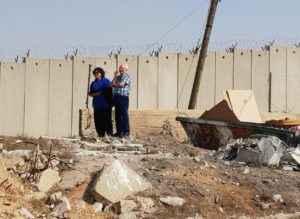I asked Israel’s only journalist in Palestine to show me something shocking – and this is what I saw

Robert Fisk and Amira Hass walk alongside a section of ‘The Wall’
Robert Fisk writes in the Independent:
Show me something that will shock me, I told Amira Hass. So Israel’s only journalist in the Palestinian West Bank – or Palestine, if you still believe in so unorthodox a word – took me down a road outside Ramallah that I remember as a highway which led to Jerusalem. But now, just over a hill, it deteriorates into a half tarmac road, a set of closed, rusting shop doors, and garbage. The same old summer smell of raw sewage creeps up the road. It lies, green and gentle, in a pool at the bottom of the wall.
Or The Wall. Or, for more cautious scribes, the “Security Wall”. Or, for more squeamish souls, the “Security Barrier”. Or for even more slovenly pens, just the “Barrier”. Or, if you’re really worried about the political implications, the “Fence”. The Fence – like the friendly wooden posts and crossbeams you might find along the edge of a field. Or – if you really want to frighten the TV editors and anger the Israelis – the “Segregation Wall” or even the “Apartheid Wall”. Why, soon we will be talking about the Palestinian “Bantustans” that lie cut off by The Wall and the Israelis-only roads, and the vast empire of Jewish settlements on Arab lands.
Trust Amira to start the ball rolling. The phrase “Palestinian Bantustan” litters her angry digression as she takes me around the Palestinian enclaves of the West Bank and, after an hour or two, the Wall: towering 26 feet above us, stern, monstrous in its determination, curling and snaking between apartment blocks, and skulking in wadis and twisting back on itself until you have two walls one after the other, a double wall but the same wall such are the Alpine twists of this creature. You shake your head for a moment when – suddenly, through some miscalculation, surely – there is no wall at all but a shopping street or a bare hillside of scrub and rock. And then the massive colonial project of Israel’s settlements, all green trees and red-roofed houses and neat roads and, yes, more walls and barbed wire fences and yet bigger walls. And then the beast itself. The Wall.
But the section of The Wall to which Amira Hass takes me – tourist guide and analyst of Israeli society, she admits, do not go together – is a truly miserable place. Not as epic as Dante. Maybe a war correspondent could better describe the place. It’s the old road from Ramallah to Jerusalem, lined with lost wealth and forgotten hopes and once-loved homes which now end, of course, at The Wall. “Now if this is not shocking, I don’t know what shocking is,” Amira says. “It’s a destruction of people’s life – it’s the end of the world. See here? We go straight to Jerusalem. Not now. This was a busy road and you can see here how people invested in homes with a little bit of grace, the strength of the houses, the stone. Look at the Hebrew signs – because these Palestinians used to have so many Israeli customers. Even the name ‘carpenter’ is in Hebrew.”
